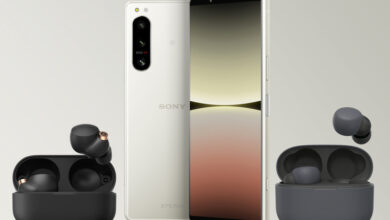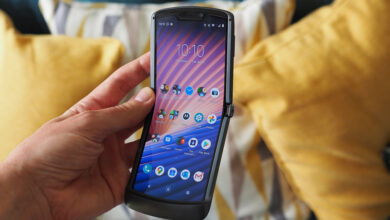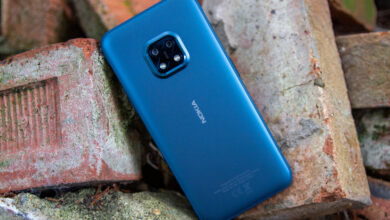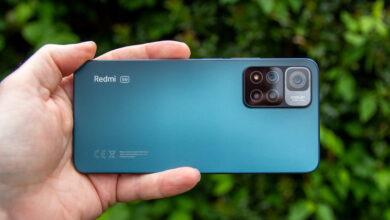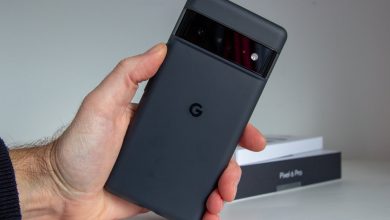Sony Xperia 10 IV vs Xperia 10 III: What’s the difference?
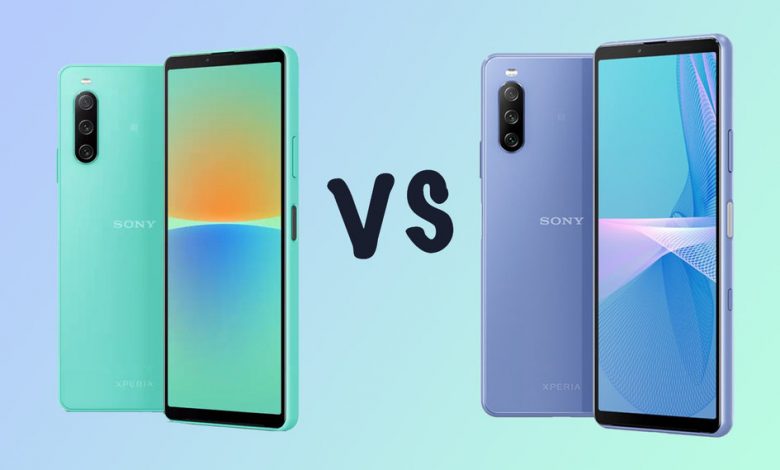
[ad_1]
(Pocket-lint) – Sony announced the Xperia 1 IV and the Xperia 10 IV at an event in May, succeeding the flagship Xperia 1 III and the mid-range Xperia 10 III.
We’ve run up a comparison of how the Xperia 1 IV stacks up against the Xperia 1 III in a separate feature, and how the Xperia 10 IV compares to the Xperia 1 IV in another feature, but here we are focusing on how the Xperia 10 IV compares to the Xperia 10 III.
Should you upgrade if you have the Xperia 10 III, or which should you choose if you are deciding between the old device and new device?
Design
- Xperia 10 IV: 153 x 67 x 8.3mm, 161g
- Xperia 10 III: 154 x 68 x 8.3 mm, 169g
The Sony Xperia 10 IV is very similar in its design to the Xperia 10 III. In fact, it would make an excellent – and very hard – game of spot the difference.
Both feature more rounded corners and edges than the premium Xperia 1, and they both come with a pill-shaped vertical rear camera housing in the top left corner. There are bezels at the top and bottom of the displays and a physical fingerprint sensor is present on the right edge.
Colour options are different between the two models – there’s also an extra colour for the Xperia 10 IV, and the Xperia 10 IV shaves off a millimetre from the width and height, reducing the bezels around the display slightly compared to the Xperia 10 III. The new model drops the weight by 5g too and it offers IP65/IP68 water and dust resistance, instead of IPX5 and IPX8.
On the whole, you’re not going to see a huge difference if you’re upgrading from the Xperia 10 III to the 2022 model in terms of design – it will be familiar. Equally, if you’re choosing between the two models, you don’t gain huge amounts opting for the newer model, though you will get the fresher colours and the slightly reduced bezels, along with the lighter design.
Display
- Xperia 10 IV: 6-inch, OLED, 21:9, Full HD+, 1.5x brighter
- Xperia 10 III: 6-inch, OLED, 21:9, Full HD+
The Sony Xperia 10 IV and the Sony Xperia 10 III both have a 6-inch OLED display and they both have a Full HD+ resolution at 2520 x 1080.
The two models also offer a standard 60Hz refresh rate, which was the norm in smartphones until 90Hz and 120Hz displays became a thing a couple of years ago, and they both have the 21:9 aspect ratio that all Sony Xperia phones have offered since 2019.
Where you’ll find differences between the Xperia 10 IV and the Xperia 10 III is the brightness of the display. The latest model is said to be 1.5x brighter than the 2021 model, which should make for more vibrancy and a better viewing experience overall.
Hardware and specs
- Xperia 10 IV: Snapdragon 695 5G, 6GB RAM, 128GB, 5000mAh
- Xperia 10 III: Snapdragon 690, 6GB RAM, 128GB, 4500mAh
As you would expect, the Sony Xperia 10 IV offers improvements in hardware compared to its predecessor. The Snapdragon 695 5G platform is at the core of the Xperia 10 IV, which should not only offer a performance boost compared to the Snapdragon 690G platform in the Xperia 10 III, but it also brings 5G connectivity.
Both devices feature 6GB of RAM and 128GB of storage though and they both have microSD support for storage expansion.
In terms of audio, the Xperia 10 IV and the Xperia 10 III both have a 3.5mm audio jack and they both support features like Hi-Res Audio and DSEE Ultimate. The Xperia 10 IV also has Sony’s 360 Reality Audio though, along with a feature called 360 Reality Audio Upmix so there are some additional features on the sound front with the new model.
The battery capacity is also slightly larger on the Xperia 10 IV, with a 5000mAh cell under the hood, up from the 4500mAh cell in the Xperia 10 III. This should deliver a decent boost in terms of daily use, though the brighter display, 5G and extra camera features – below – may eat some of that up.
Neither the Xperia 10 IV or the Xperia 10 III offer wireless charging like the Xperia 1 IV and Xperia 5 III. The Xperia 10 IV also doesn’t come with the charger or the charging cable in the box so that’s worth noting.
Camera
- Xperia 10 IV: Triple rear camera (12MP+8MP+8MP) OIS, 8MP
- Xperia 10 III: Triple rear camera (12MP+8MP+8MP), 8MP
The Sony Xperia 10 IV and the Xperia 10 III feature the same camera sensors within their triple lens systems, though the 2022 device has some additional features. Both have a 12-megapixel main sensor, 8-megapixel telephoto sensor and an 8-megapixel ultra wide-angle sensor. There’s no periscope lens and no ToF sensor like you’ll find on the Xperia 1 IV.
The main difference between the Xperia 10 IV and the Xperia 10 III is the Xperia 10 IV offer optical image stabilisation (OIS). It is also said to offer improvements to low light shooting and noise reduction when shooting in night mode.
There’s also super resolution zoom on board the Xperia 10 IV and extended dynamic range for video. Additionally, while both the Xperia 10 IV and the Xperia 10 III have an 8-megapixel front camera, the latest model will offer crisper selfies thanks to AI, according to Sony.
Conclusion
The biggest reasons to buy the Xperia 10 IV over the Xperia 10 III, or to upgrade, are the processor and battery bumps and the optical image stabilisation on the camera system. While some camera features won’t be used by everyone, OIS should make a solid difference in terms of results compared to the older model.
The other good reason to upgrade from the older model, or buy the newer model, is 5G. You’ll get faster connection speeds and in a slimmer and lighter build, with a brighter display too, so there’s not a great deal to complain about here.
You’ll likely save money opting for the older model if you’re choosing between these devices, but the Xperia 10 IV has some features worth spending the extra for, including 5G and OIS, and these features also make it a worthy upgrade too.
More about this story
When we write versus features, we take in account more than just what the spec sheets look like side-by-side. We’re looking at what improvements and updates have been made and what they mean in terms of real-world experience.
In this case, we have reviewed the Sony Xperia 10 III in full and we’ve compared it to the information about the Xperia 10 IV that we’ve been given, as well as what exists in the public domain.
The aim is to help you understand what differences there are between the two models, but also what these differences mean to allow you to make an informed decision about which model is best for you.
Writing by Britta O’Boyle.
var _pl_settings={“lang”:”en-gb”,”language”:”English”,”lang_name”:”English”,”article_adverts”:true,”super_tag”:”Phones”,”article_id”:161057,”targeting”:[[“Tag”,[“Phones”,”Sony Mobile”]],[“Type”,[“buyers-guides”]],[“Language”,[“English”]],[“PageStyle”,[“Article”]],[“inskin_yes”,[“true”]],[“Gallery”,[0]],[“Supertag”,[“Phones”]],[“PageID”,[“161057”]]]},_pl_files={“low”:[“https://apis.google.com/js/platform.js”,”https://connect.facebook.net/en_GB/all.js#xfbml=1&appId=373440233087″,”https://platform.twitter.com/widgets.js”,”//cdn.viglink.com/api/vglnk.js”],”high”:[]},___gcfg={“lang”:”en-GB”},___pl_lang={“lang”:”en-gb”,”lang_name”:”English”},_sf_async_config={“uid”:12986,”domain”:”pocket-lint.com”,”useCanonical”:”true”,”sections”:”Phones, English”,”authors”:”Britta O’Boyle”},vglnk={“key”:”d70aaa6cc9f811e1c068c9f6a8469e19″};
!function (f, b, e, v, n, t, s) {
if (f.fbq) return;
n = f.fbq = function () {
n.callMethod ?
n.callMethod.apply(n, arguments) : n.queue.push(arguments)
};
if (!f._fbq) f._fbq = n;
n.push = n;
n.loaded = !0;
n.version = ‘2.0’;
n.queue = [];
t = b.createElement(e);
t.async = !0;
t.src = v;
s = b.getElementsByTagName(e)[0];
s.parentNode.insertBefore(t, s)
}(window, document, ‘script’,
‘https://connect.facebook.net/en_US/fbevents.js’);
fbq(‘init’, ‘379461843790745’);
fbq(‘track’, ‘PageView’);
[ad_2]
Source link


